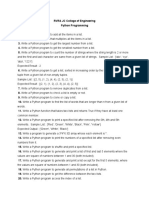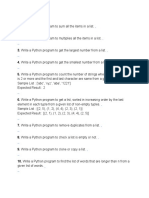Python QB-1
Uploaded by
dasm04675Python QB-1
Uploaded by
dasm046751. Given an unsorted array of integers nums, return the length of the longest consecutive elements sequence.
Input: nums = [100,4,200,1,3,2]
Output: 4
2. Given an integer array nums, return the maximum difference between two successive elements in its sorted form. If the array
contains less than two elements, return 0.
Input: nums = [3,6,9,1]
Output: 3
3. Print the following pattern.
*
***
*****
*******
4. Print the following pattern.
1
23
456
7 8 9 10
11 12 13 14 15
5. Print the following pattern.
A
BC
DEF
GHIJ
KLMNO
6. Write a function to find the longest common prefix string amongst an array of strings. If there is no common prefix, return an
empty string. Example 1:
Input: strs = ["flower","flow","flight"]
Output: "fl"
7. Python code to get the Cumulative sum of a list
8. Python code to count the number of occurrences of an item in a list.
9. Write a Python program to check a list is empty or not.
10. Python program to check if a string has at least one letter and one number.
11. Python program to capitalize the first and last character of each word in a string
12. Python program to implement call by reference.
13. Write a Python program to add two given lists using map and lambda.
14. Write a Python program that multiply each number of given list with a given number using lambda function. Print the result.
15. Print the following pattern.
16. Check that a number is palindrome or not.
17. Print the following pattern:
*
**
***
****
*****
18. Write a Python program to input a 5 × 5 matrix and print the 2nd row, and 3rd element in 4th row.
19. Two strings are anagrams if you can make one from the other by rearranging the letters.Write a function named is_anagram
that takes two strings as its parameters. Your function should return True if the strings are anagrams, and False otherwise.
20. Program to accept the strings which contain all vowels.
21. Frequency of all numbers in String.
22. Python program to implement variable function argument and thereby find out area of a rectangle.
23. Write a Python program to find numbers divisible by nineteen or thirteen from a list of numbers using Lambda.
24. Python program to find the sum of all items in a dictionary.
25. Python code to display the words in a phrase that have the greatest and lowest ASCII values of characters.
26. Transform a String into a matrix with K characters each row.
27. Given the participants' score sheet for your University Sports Day, you are required to find the runner-up score. You are given
n scores. Store them in a list and find the score of the runner-up.
i/p: n=6
236654
o/p= 5
28. Input the string (Honorificabilit) and check for the minimum frequent vowel and maximum frequent
consonant.
29. Find out the 3rd highest element from an input list.
30. write a function that accepts a number as a parameter. The function should return a number that’s the difference between the
largest and smallest numbers that the digits can form in the number.
For example, if the parameter is “213”, the function should return “198”, which is the result of 123 subtracted from 321.
You might also like
- List of Important Programs-Python ProgrammingNo ratings yetList of Important Programs-Python Programming3 pages
- Assignment 4092 Content Document 20250118101645AMNo ratings yetAssignment 4092 Content Document 20250118101645AM3 pages
- Python Practical Questions For HND PearsonNo ratings yetPython Practical Questions For HND Pearson7 pages
- Sr. No List of Practicals 1. 2. 3. 4. 5. 6No ratings yetSr. No List of Practicals 1. 2. 3. 4. 5. 64 pages
- Enter Your Name Nishigandha Enter Your Age 22 Nishigandha You Will Turn 100 Years Old in 2098100% (1)Enter Your Name Nishigandha Enter Your Age 22 Nishigandha You Will Turn 100 Years Old in 209814 pages
- 6phrase - Myslate - Python - Session PlanNo ratings yet6phrase - Myslate - Python - Session Plan19 pages
- Class 12 CSC Practical Record File 2024-25 Final50% (2)Class 12 CSC Practical Record File 2024-25 Final11 pages
- JDS2900 Function Generator Serial USB Protocol ManualNo ratings yetJDS2900 Function Generator Serial USB Protocol Manual10 pages
- Job Seeker Computer Skills Self-Assessment Name (Please Print) : - DateNo ratings yetJob Seeker Computer Skills Self-Assessment Name (Please Print) : - Date1 page
- NICE Recording 6.3 - Maintenance ManualNo ratings yetNICE Recording 6.3 - Maintenance Manual39 pages
- Network Storage Router E1200 160 User GuideNo ratings yetNetwork Storage Router E1200 160 User Guide200 pages
- VGD - Checklist of Tools Equipment SuppliesNo ratings yetVGD - Checklist of Tools Equipment Supplies2 pages
- Exposing The XI Monitoring Functionality As A Web ServiceNo ratings yetExposing The XI Monitoring Functionality As A Web Service20 pages
- Data Structures Technical Interview QuestionsNo ratings yetData Structures Technical Interview Questions11 pages
- Dell EMC PowerEdge R7525 Installation and Service ManualNo ratings yetDell EMC PowerEdge R7525 Installation and Service Manual194 pages
- Adama Science and Technology UniversityNo ratings yetAdama Science and Technology University37 pages

























































































